If you’ve never had farm fresh eggs, you might not know that they come in an assortment of colors. Chickens lay brown eggs, white eggs, pink eggs, blue eggs, green eggs, and even purplish eggs. Who needs the Easter Bunny when there are chickens that produce so many beautifully colorful eggs on their own? Still, there’s something neat about chalky, snow-white eggs and creamy eggs with a satin sheen. Here is a list of some of the most recognized chicken breeds that lay white eggs.
Ancona Chicken
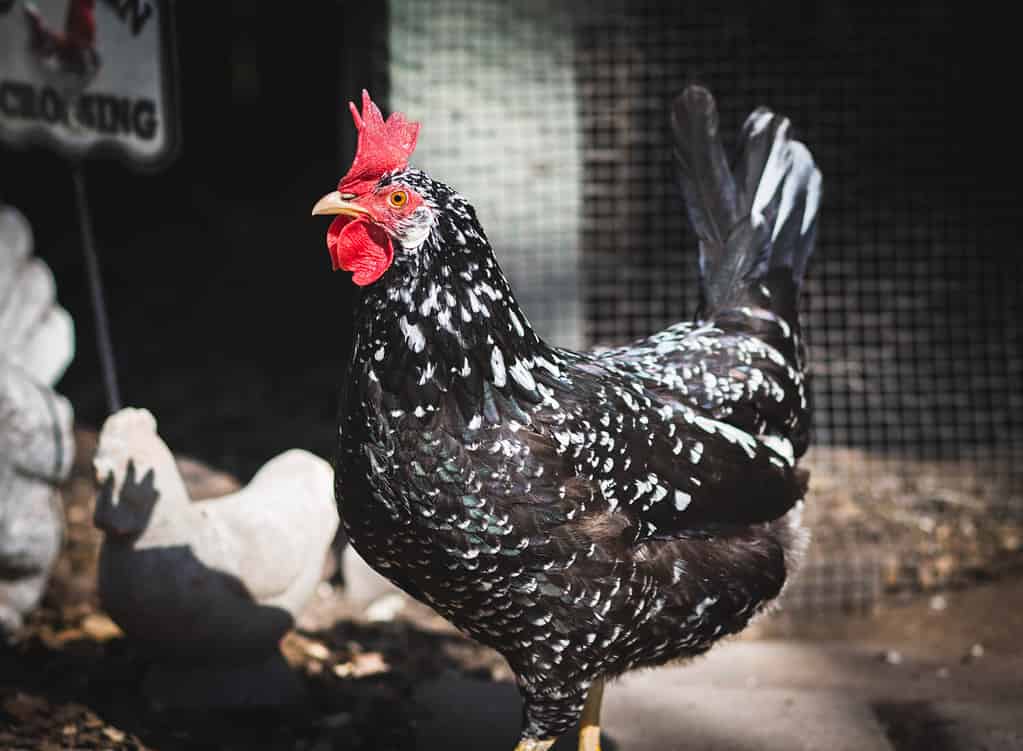
The mottled Ancona chicken tends to get more white-tipped feathers with each molt.
©JennGarcia/Shutterstock.com
Ancona chickens lay medium to large-sized, white eggs. Hens lay 180 to 220 eggs per year, which equals around 4 eggs per week.
The Ancona chicken, named for the port city of Ancona in Italy, developed from Leghorn chickens and other birds centuries ago. In the latter half of the 19th century, breeders began exporting the Ancona chicken to England and later the United States. The American Poultry Association recognizes this mottled breed in both rose comb and single comb variations and in large and bantam sizes. The standard requires that birds have a black background with white markings. Breeders tend to prefer darker birds over lighter ones, as they get more mottled with each molt.
Andalusian Chicken
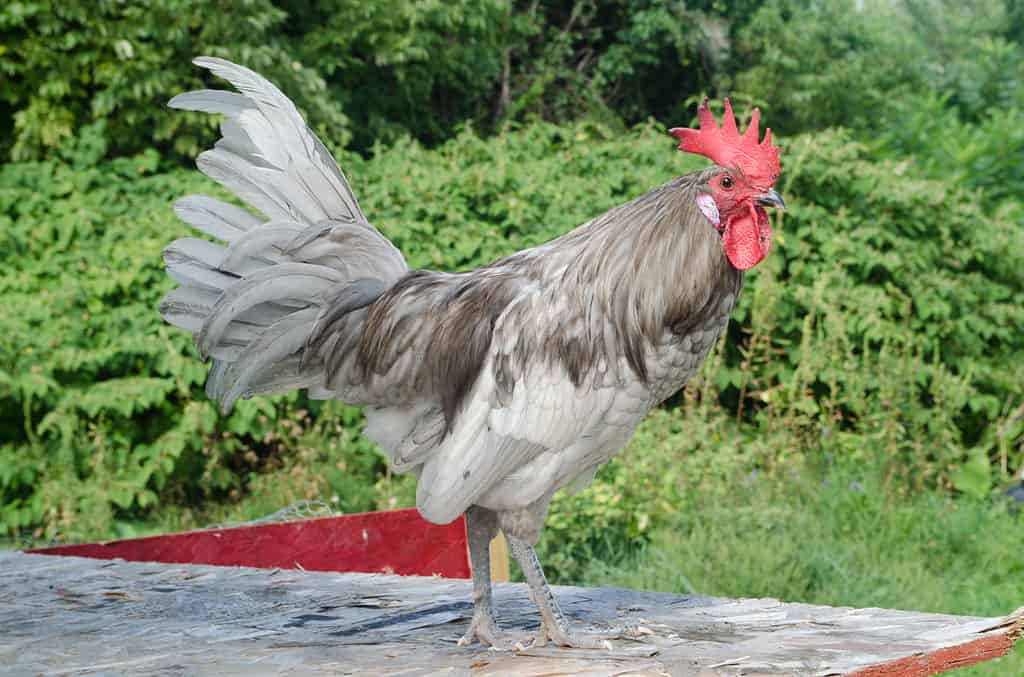
The blue Andalusian chicken can come in slate blue, black or splash color variations.
©Pegasene/Shutterstock.com
Andalusian chickens lay medium to large white eggs. Hens produce an average of 150 to 200 eggs per year, or about 3 to 4 eggs per week.
The Andalusian is a somewhat rare chicken originally from Spain. Owners selectively breed this bird for the most desirable deep, slate-blue color. Although blue is the single recognized variety of Andalusian chickens, not all of them come out that color. Due to a genetic factor known as incomplete dominance, some blue Andalusian chickens turn out black, and others present with a color known as splash, which features mostly white feathers with splashes of black or blue. The Livestock Conservancy currently lists the Andalusian chicken in the watch category on its Conservation Priority List.
Campine Chicken
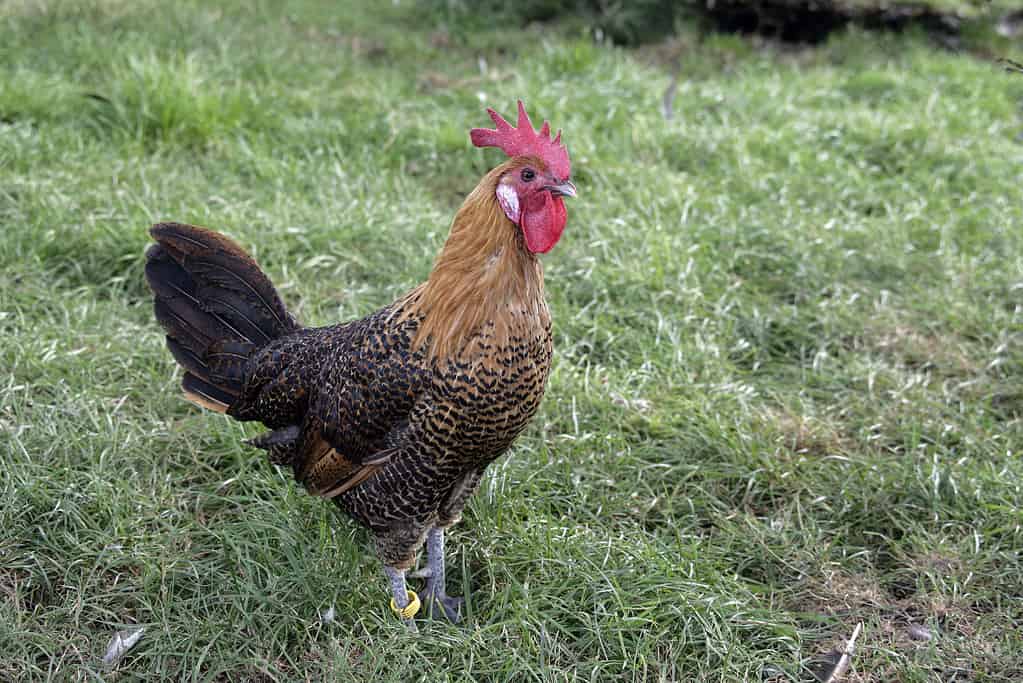
The rare Campine chicken is an excellent egg producer descended from Turkish fowl.
©Erni/Shutterstock.com
Campine chickens lay medium-sized, white eggs. Hens produce approximately 140 to 200 eggs per year. That translates to about 3 to 4 eggs each week.
The small and slender Campine chicken is an ancient breed descended from Turkish fowl. It originated in the lowlands in the Flemish region of Belgium and part of the southeast Netherlands. Breeders developed the Campine chicken for its robust egg production, then exported the birds across Europe and to the United States. Unfortunately, bigger and better egg-producing birds caused the Campine chicken’s popularity to plummet after the early 20th century. Though once in demand, the Livestock Conservancy lists this breed as critical, and it is now among the rarest chickens in the world.
Crevecoeur Chicken

The Crèvecoeur chicken, a French breed from Normandy, nearly went extinct in World War II.
©slowmotiongli/iStock via Getty Images
Crèvecoeur chickens lay medium to large size, white eggs. Hens produce an average of 120 to 150 eggs per year. That amounts to about 2 to 3 eggs per week.
The Crèvecoeur chicken, named for the town of Crève-Coeur en Ange, may be the oldest chicken to have originated in France. These handsome birds with shaggy crests, beards, and upright, curved tails come only in shiny, solid black. Crèvecoeur chickens have an inspirational story of survival. They were nearly wiped out when Germany invaded in World War II, but some survived thanks to farmers who hid them away. Breeders in France, Australia, and the United States have worked so hard to rebuild the breed, the Livestock Conservancy has moved it from the critical category to the watch category in recent years.
Dorking Chicken
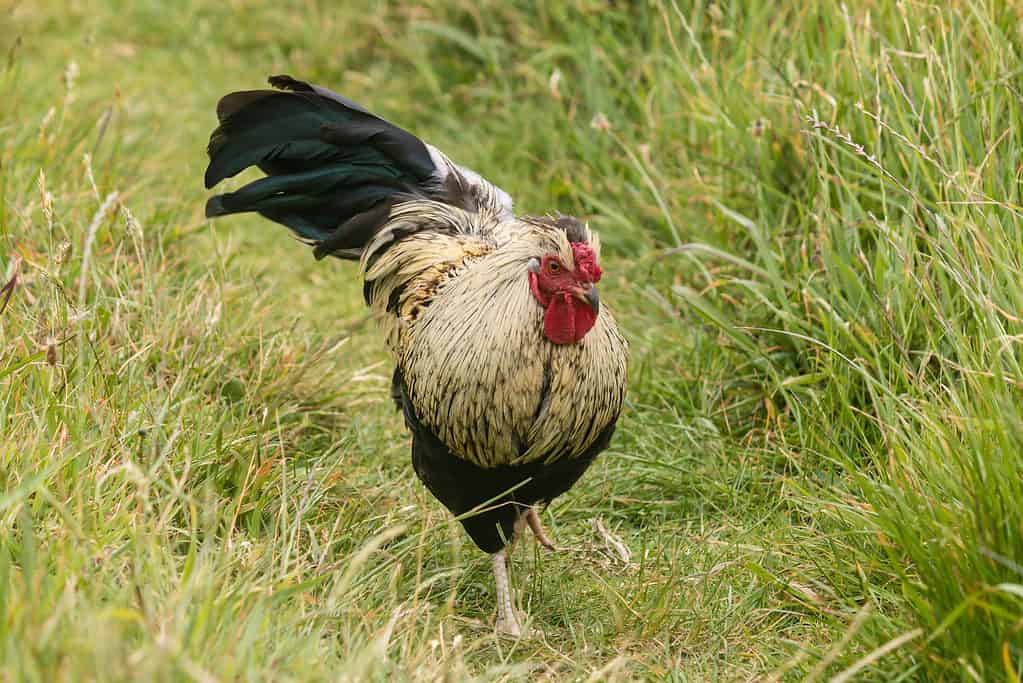
Unlike most chickens, which have four toes on each foot, the Dorking chicken has five.
©iStock.com/PatrikStedrak
Dorking chickens lay medium to large size, creamy white eggs. Hens produce an average of 170 to 190 eggs per year. That equals roughly 3 to 4 eggs per week.
The Dorking chicken is a sturdy, five-toed bird that reaches up to 9 pounds. The APA recognizes five different colors and two different types of combs in this breed. Dorking chickens are an ancient breed, possibly brought to Britain during the Roman conquest. Breeders developed this fowl in southern England and named it after the town of Dorking. By the mid-1800s, this breed had become popular in the United States, and it was the favorite breed across England by the turn of the 20th century. Unfortunately, the Dorking chicken’s popularity rapidly declined with the development of the commercial poultry industry. The Livestock Conservancy currently lists the Dorking chicken as threatened, with fewer than 5,000 birds worldwide.
Hamburg Chicken
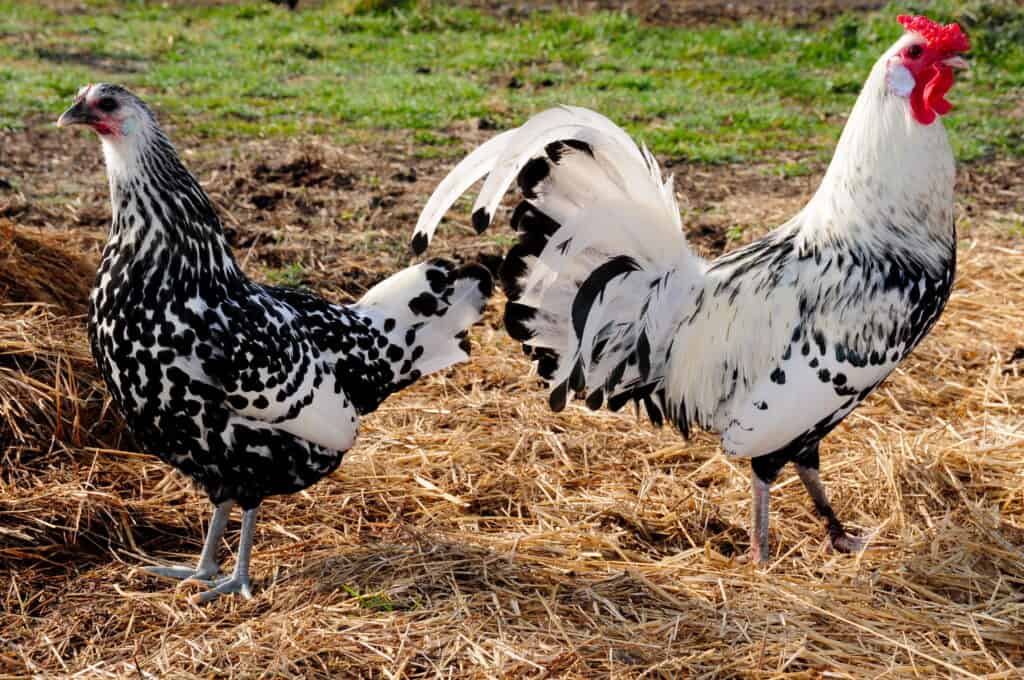
Tiny Hamburg chickens, known for their beautiful feathers, lay small, pointed, white eggs.
©Amy McNabb/Shutterstock.com
Hamburg chickens lay small to medium, white eggs with a rather pointy end. Hens produce a lot of eggs, ranging from 200 to 250 per year. That amounts to about 4 to 5 eggs per week.
The beautiful Hamburg chicken is a small bird weighing only about 5 pounds. It is one of the oldest known breeds, with its known existence extending all the way back to the Netherlands at the end of the Middle Ages. By the late 18th century, Hamburg chickens had made their way to England. In 1800, historians say two Hamburg roosters faced off in the first chicken show in the country. English breeders soon developed multiple varieties of the breed, including black, white, spangled, and penciled types. Sadly, though Hamburg chickens produced a large amount of eggs, interest in the breed waned with the development of Leghorns. The Livestock Conservancy currently lists Hamburg chickens as threatened.
Holland Chicken

The Holland chicken is the rarest living breed to have originated in the United States.
©Jos Everts/iStock via Getty Images
Holland chickens lay medium to large, white eggs. Hens produce a generous 200 to 240 eggs per year, equaling roughly 4 to 5 eggs per week.
The Holland chicken was developed in the United States from birds that were imported from Holland and crossed with several other breeds. Breeders at Rutgers University in New Jersey wanted to create a really good dual-purpose bird that also laid white eggs. They ended up with two varieties, one white and the other barred, but both well made for both egg and meat production. The barred Holland chicken enjoyed more popularity than the white variety, but neither fared well in the long run. Unfortunately, according to the Livestock Conservancy, the Holland chicken is the rarest American chicken alive today, and the white variety appears to have already gone extinct.
Houdan Chicken

The Houdan chicken, recognized in white and mottled varieties, has an impressive crest.
©Ann Porteus / CC BY 2.0 – License
Houdan chickens lay large, white eggs. Hens produce about 150 to 230 eggs per year. On average, that equals 3 to nearly 5 eggs per week.
The Houdan chicken, a large bird known for its impressive crest, originated from ancient birds in France. Breeders eventually crossed Houdan chickens with other breeds to create a dual-purpose bird, improving both size and growth rate. These large birds became known as some of the most succulent and tasty fowl in France. The APA currently recognizes the mottled Houdan chicken, introduced in America in 1865, and the white variety, developed in the United States. Houdan chickens nearly went extinct before the turn of the 21st century. The Livestock Conservancy now lists this breed as threatened.
La Fleche Chicken
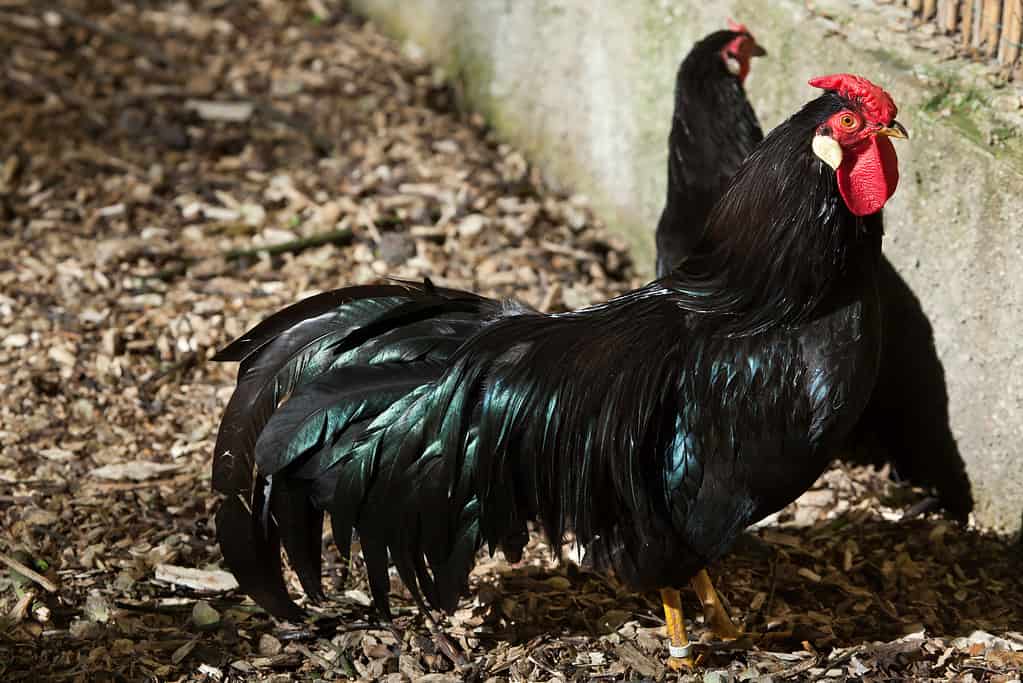
The La Fleche chicken is named for the town of La Fleche, near where it originated in France.
©wrangel/iStock via Getty Images
La Fleche chickens lay large to extra-large, white eggs. Hens average between 140 to 220 eggs per year, but they generally only lay in the warmer months from March through October.
The La Fleche chicken, with its shiny black feathers and bright red, arrow-shaped comb is an excellent dual-purpose bird. The breed reaches weights of up to 8.5 pounds, has tender and succulent meat, and produces a large quantity of eggs at least part of the year. But this bird, which originated near the town of La Fleche in France, has no love for humans. Sometimes called Satan’s fowl or the devil bird, the flighty and aloof La Fleche chicken simply wasn’t hardy enough or friendly enough to endear itself to most farmers. Recognized by the APA in only the black variety, this breed currently sits on the Livestock Conservancy’s critical list.
Lakenvelder Chicken
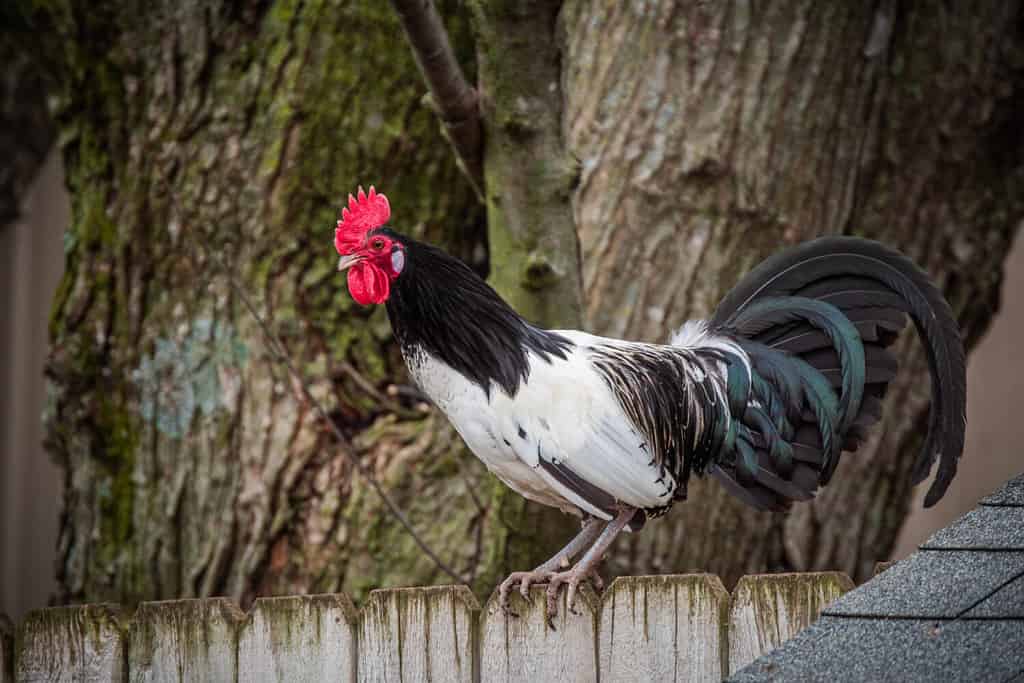
©Abigail Schmidt/Shutterstock.com
The Lakenvelder chicken descends from some of the oldest chickens in the world.
Lakenvelder chickens lay small to medium-sized, white to lightly tinted eggs. Hens produce between 150 to 200 per year, an average of approximately 3 to 4 eggs per week.
The striking black and white Lakenvelder chicken descends from chickens that lived at least 4,000 years ago. These ancestor breeds were brought along with Jewish immigrants who came from the ancient city of Megiddo to Europe. Along the border of Holland and Germany, possibly around the beginning of the 18th century, breeders developed the Lakenvelder chicken. Exporters spread the breed to England and the United States around the turn of the 20th century. The APA recognizes only the one black and white color variation. The Livestock Conservancy currently lists the breed as threatened.
Leghorn Chicken

The highly productive Leghorn chicken leads the way in the commercial egg industry in the United States.
©slowmotiongli/Shutterstock.com
Leghorn chickens lay large, white eggs best known as the ones you might see in the grocery store. Hens produce between 150 to 320 eggs per year, depending on the variety. The industrial variety produces the most, while the non-industrial, heritage breed produces fewer eggs.
The hardy, productive Leghorn chicken originated in the Tuscany region in Italy. People usually think of the white, industrial variety when they envision Leghorn chickens. However, the APA currently recognizes several colors and patterns, including six varieties in the large size, and 11 different varieties in the bantam size. Although the industrial-type Leghorn is the powerhouse of the commercial egg industry in the United States, the non-industrial bird is also popular in small flocks. The Livestock Conservancy currently lists the non-industrial Leghorn as a recovering breed.
Minorca Chicken
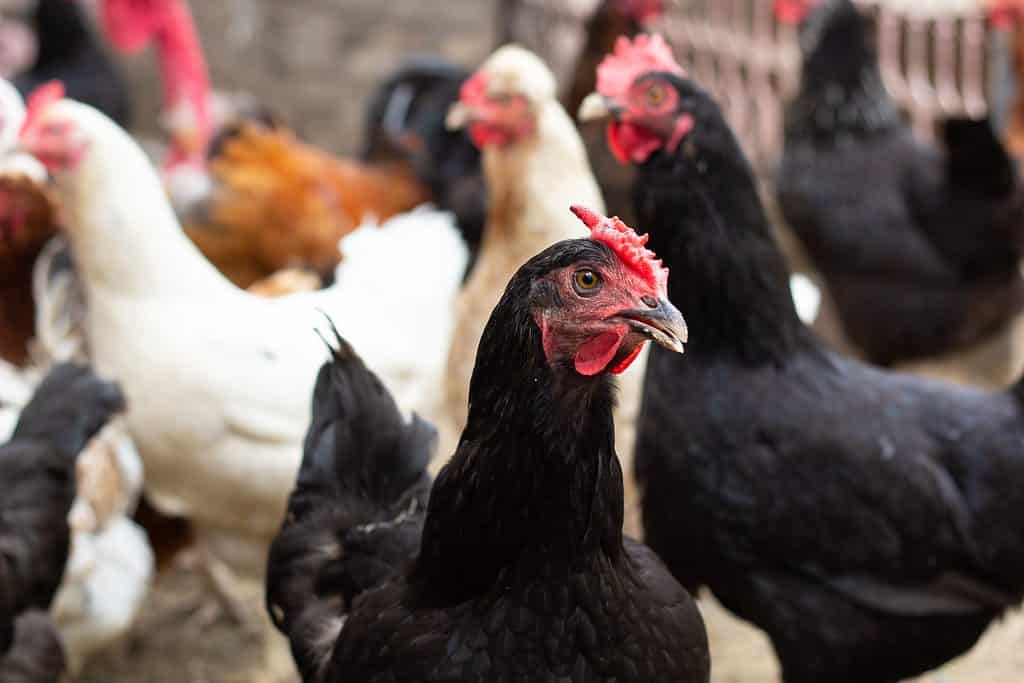
The Minorca chicken is a large Spanish breed developed for both meat and egg production.
©Jane Nadezhina/Shutterstock.com
Minorca chickens lay extra-large, chalk-white eggs. Hens produce between 120 to 220 per year, or roughly 3 to 4 eggs per week, with the number depending mainly on the variety.
The Minorca chicken, a large chicken weighing up to 9 pounds, has a long history in Spain. It once had a large population on the island of Minorca, just off the coast. This breed was exported to England by the late 18th century, and almost a century later to the United States. Not only do these big chickens lay extra-large white eggs, they also provide substantial meat. The APA recognizes straight comb varieties in three colors, and rose comb varieties in two.
Modern Game Chicken
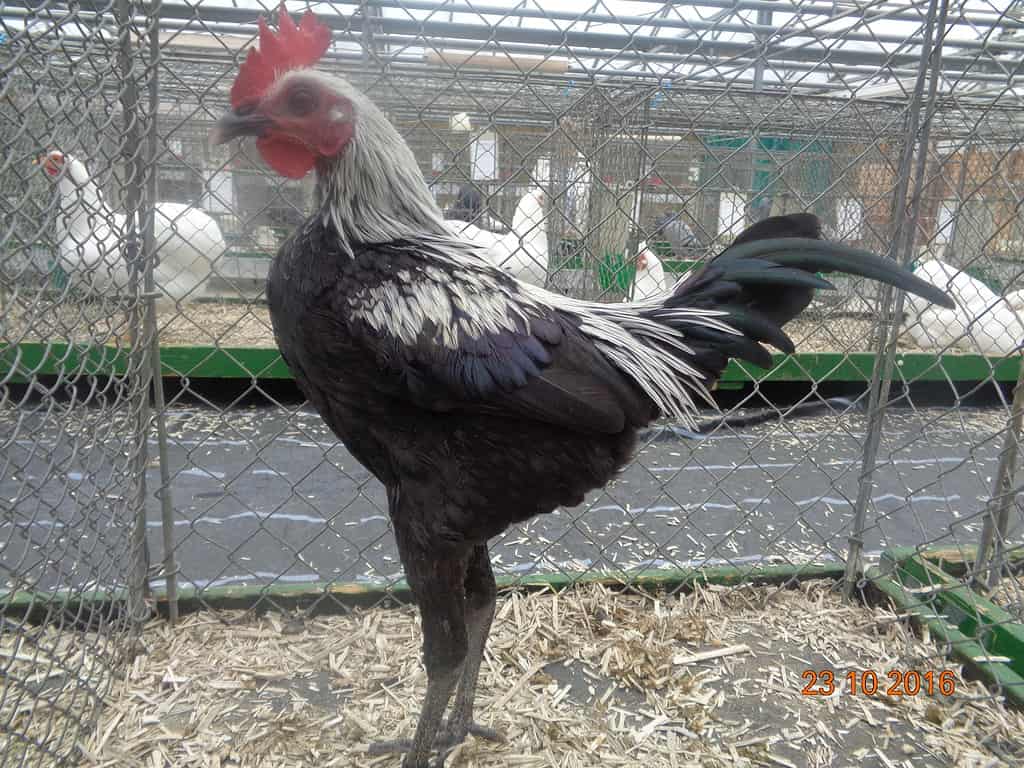
The Modern Game chicken has a long, lanky body that has been compared to a ballerina.
©Uikitireza / CC BY-SA 4.0 – License
Modern Game chickens rank among the poorest egg producers on this list. They lay only 50 to 80 small, white or lightly tinted eggs per year. That equals only about 1 to 2 eggs per week.
The graceful Modern Game chicken, though tall and lean, only reaches weights of about 6 pounds. Breeders introduced this lanky chicken in Great Britain in 1849 as an exhibition bird. They had developed this breed in direct response to a new law that banned cockfighting. The Modern Game chicken developed from crosses between Old English Game chickens and Malay chickens. Modern Game chickens come in an array of interesting colors and patterns. The APA recognizes nine different colors for the large fowl and 14 different color variations for bantam-sized birds. The Livestock Conservancy lists this breed as threatened.
Old English Game Chicken
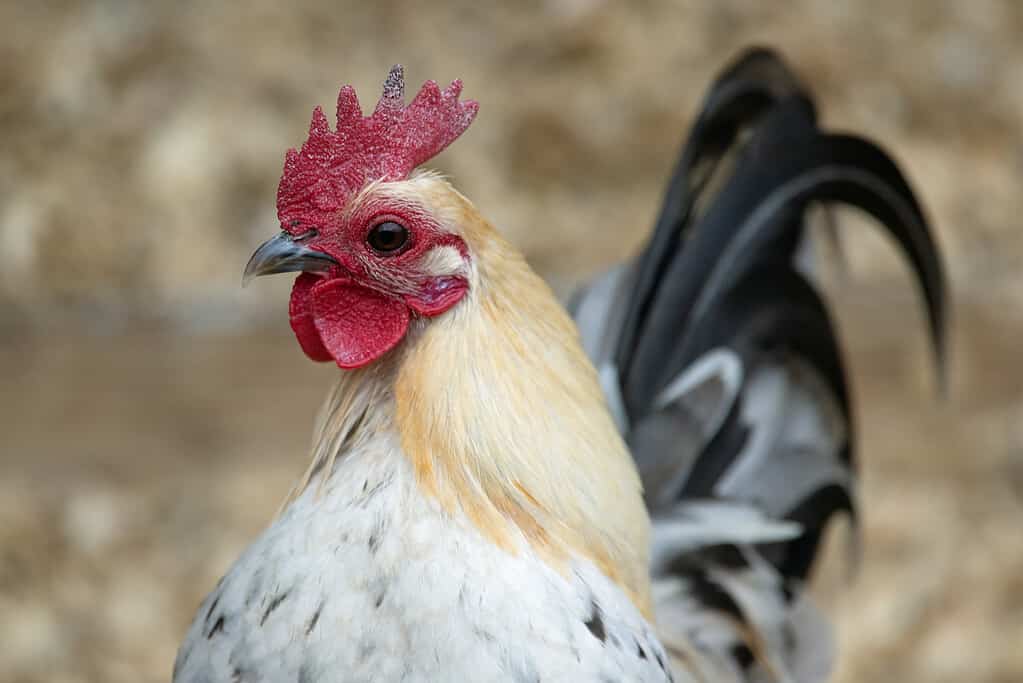
The Old English Game chicken has far more recognized color variations than almost any other fowl.
©JZHunt/iStock via Getty Images
Old English Game chickens lay medium-sized, creamy white eggs. Hens produce only about 100 to 160 eggs per year. That doubles the amount of the Modern Game chicken, but it still only averages 2 to 3 eggs per week.
The Old English Game chicken’s beautiful plumage may have saved it from extinction after cockfighting was banned in England in 1849. The breed had originated as a fighting bird there, but it managed to persist as a show bird. Old English Game chickens, bred now for variety, are among the most colorful chickens in the world. The APA currently recognizes an amazing 28 different types in the bantam size, and 14 colors and patterns in the large variety. Despite their beauty, the Old English Game chicken still exhibits aggressive tendencies, and roosters must be kept separately so they do not fight to the death. The Livestock Conservancy currently includes this breed on the watch list.
Polish Chicken

Do not sneak up on Polish chickens. Their crests obscure their vision and can cause them to startle easily.
©Microfile.org/Shutterstock.com
Polish chickens lay medium to large size, white eggs. Hens produce around 150 to 200 eggs per year, which equates to 3 to 4 eggs per week.
The Polish chicken, in its modern form, originated in the Netherlands, not Poland. Likely named for the Dutch word, Pol, which means big head, this breed features large, round, feathery crests. Their skull even has a rounded protrusion, shaped like a hollow ping pong ball, which supports the crest. It causes their brain to grow in the shape of a peanut. In addition to their elaborate crests, some variations of Polish chickens have matching beards and muffs. The APA recognizes 11 different color variations of Polish chickens.
Redcap Chicken

The Redcap chicken is one of the world’s oldest dual-purpose chickens.
©Shawn Fair/iStock via Getty Images
Redcap chickens lay large, white eggs. Hens produce about 150 to 200 eggs per year, which equals 3 to 4 eggs per week.
The Redcap chicken, sometimes called the Derbyshire Redcap, originated in England. This dark, reddish chicken with a unique rose comb was exported to the United States and became well-established by the 1870s. Although the Redcap chicken proved to be a good dual-purpose breed, it nearly went extinct both in England and the United States. The Livestock Conservancy lists the breed as critical, but thanks to conservation efforts it continues to hold on.
Sicilian Buttercup Chicken

Sicilian Buttercup chickens arose on the island of Sicily off the coast of Italy.
©LeeGillion/iStock via Getty Images
The Sicilian Buttercup chicken lays small to medium size, white eggs. Hens produce around 140 to 180 eggs per year. That equals an average of a little more than 3 eggs per week.
Sicilian Buttercup chickens are decidedly weird. These medium-sized birds originated in Sicily and arrived in the United States in the mid-1800s. Breeders focused on preserving the green legs and the oddly shaped comb over standardizing plumage. The Sicilian Buttercup has a double comb, attached at the front and back to form what looks like a cup-shaped flower or a wonky red crown. Males and females of this breed share a similar shape, but their plumage is no match at all. Roosters appear mostly red-orange with black tails, and hens look golden with lots of black speckles. The Livestock Conservancy lists this breed as threatened.
Sultan Chicken
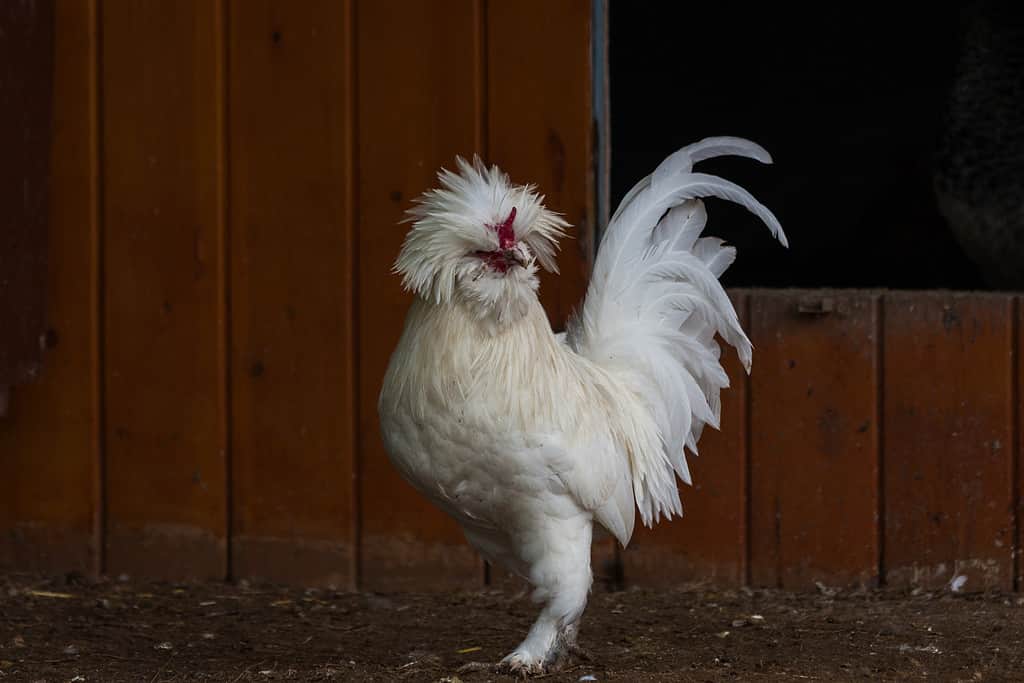
Though once a favorite of royalty, very few Sultan chickens exist in the world today.
©09arts/Shutterstock.com
Sultan chickens are another of the poorest egg producers on the list. Hens lay only 50 to 100 small, white eggs each year. That equals no more than 1 or 2 eggs per week.
The Sultan chicken was not bred for egg production, though. This breed, known as the Fowl of the Sultan, held a place of high esteem in the palace of the Sultan of the Ottoman Empire. It even found itself in the menagerie of Louis XIV in Versailles. Appreciated today, even as it was centuries ago, for its ornamental qualities, the Sultan chicken is recognized only in a pure, snowy white color. The Livestock Conservancy currently lists the Sultan chicken in its critically endangered category. Fewer than 1,000 mature birds still exist worldwide.
Sumatra Chicken
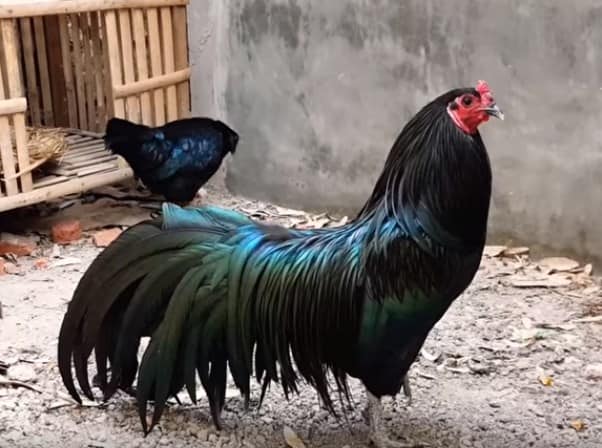
©Dimas pramuditha / CC BY-SA 4.0 – License
Black Sumatra chickens have flowing feathers with a metallic green sheen.
Sumatra chickens lay up to 100 small, white to lightly tinted eggs each year. That averages fewer than 2 eggs per week.
The shape of the Sumatra chicken resembles ancient jungle fowl native to southeast Asia. Its black plumage shines with a metallic, green sheen, and its long tail feathers flow gracefully behind its sleek body. This graceful, flighty bird originated in the wild in Indonesia, on the islands of Sumatra, Java, and Borneo. It reaches a weight of only 5 pounds, and it produces little meat. Exported to the United States in 1847, and later to Europe, the Sumatra chicken has always been an ornamental bird. The Livestock Conservancy currently lists this breed as threatened.
White-faced Black Spanish Chicken
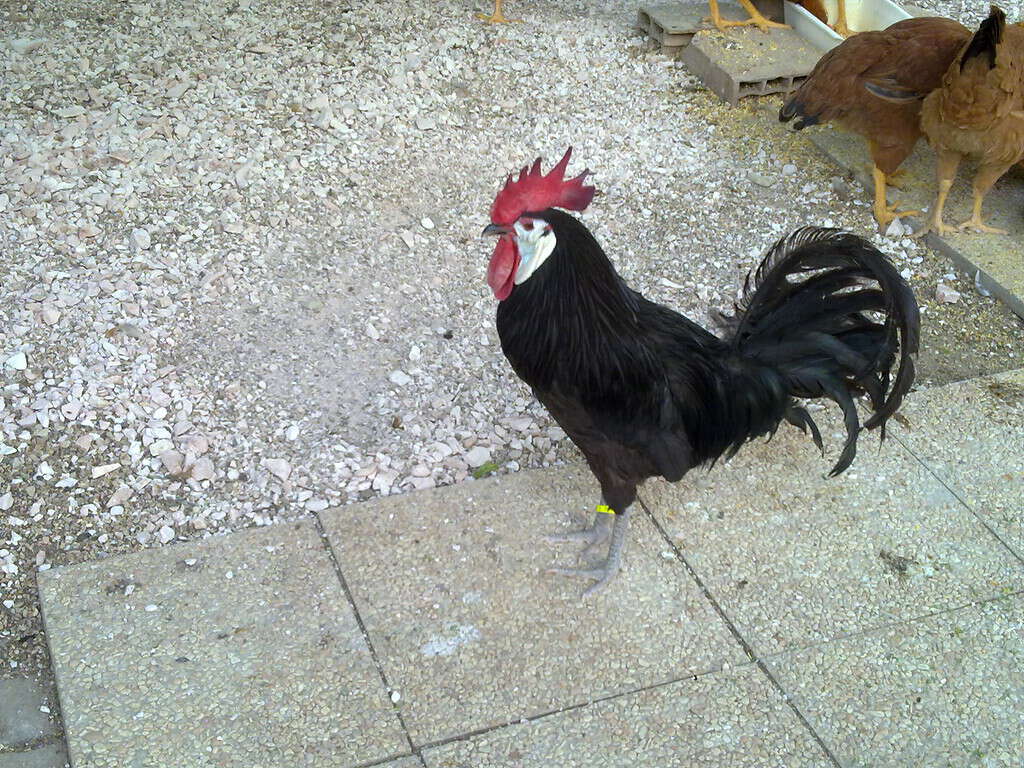
White-faced Black Spanish chickens have humongous white earlobes set against glossy black plumage.
©Galloramenu / CC BY-SA 3.0 – License
The White-faced Black Spanish chicken lays large white eggs. Hens lay up to 180 eggs per year, or an average of nearly 4 eggs per week.
White-faced Black Spanish chickens, as their name would imply, originated in Spain. They made their way to the Americas by way of the Caribbean islands. These striking black chickens have white faces with huge, white earlobes. White-faced Black Spanish chickens have tall, red combs and high-arching sickle feathers in their tails. Although these chickens lay a good number of eggs, they were bred for appearance over hardiness. Today, the Livestock Conservancy lists the breed as critical.
Yokohama Chicken
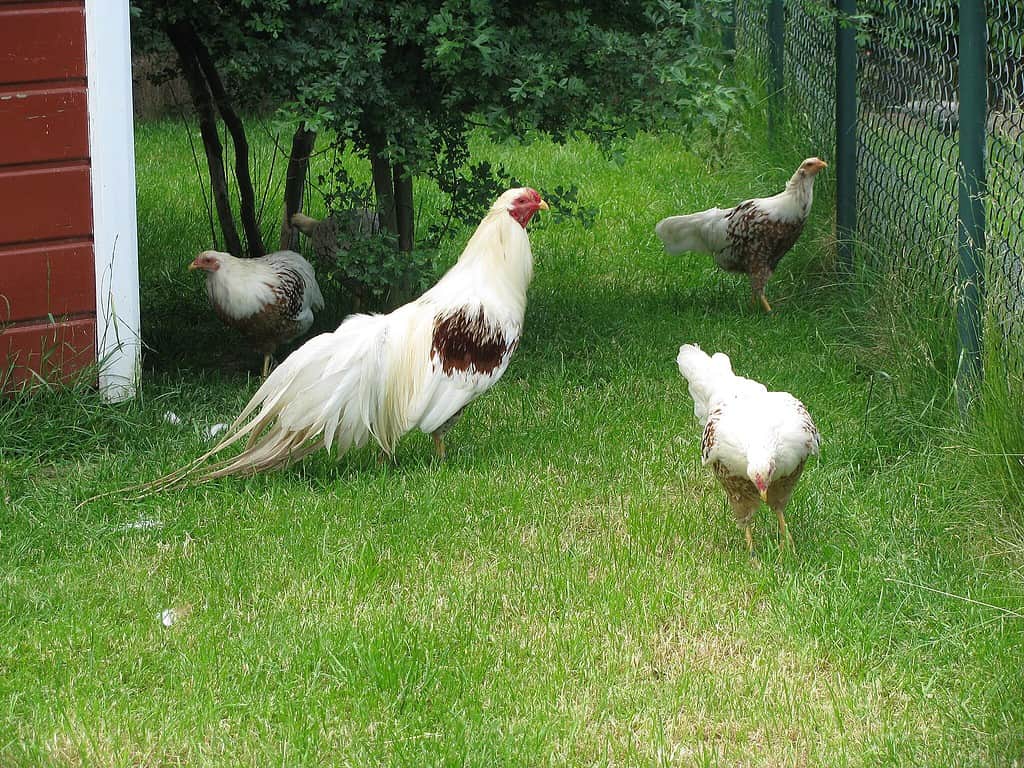
The long, beautiful tail feathers of the Yokohama chicken make it challenging for inexperienced breeders.
©Hagen Graebner / CC BY-SA 3.0 – License
Yokohama chickens rank as another of the worst egg producers on this list. They lay only about 50 to 80 small, creamy white eggs per year.
The Yokohama chicken, a strictly ornamental breed, has long, beautiful feathers that grow up to four feet in length. Also known as the Minohiki chicken in Japan, exporters took this breed from the Yokohama port to Europe in 1864. Known mainly for their luxurious feathers, Yokohama chickens are admired for their beauty and grace. However, inexperienced breeders have little chance of actually raising the birds because those feathers take so much care. With fewer than 1,000 mature birds currently known worldwide, the Livestock Conservancy lists the Yokohama chicken in their critically endangered category.
Summary of Chicken Breeds That Lay White Eggs
Many breeds of chickens lay white eggs. This list of chicken breeds that lay white eggs is not exhaustive, but it does include many of the most common large fowl recognized by the American Poultry Association. Below, you can review a summary of the chickens included in this article, along with the colors and sizes of their eggs and about how many eggs they lay each year.
| Name of Breed | Egg Color | Egg Size | Number/year |
|---|---|---|---|
| Ancona chicken | White | Medium to Large | 180 to 220 |
| Andalusian chicken | White | Medium to Large | 150 to 200 |
| Campine chicken | White | Medium | 140 to 200 |
| Crevecoeur chicken | White | Medium to Large | 120 to 150 |
| Dorking chicken | Creamy white | Medium to Large | 170 to 190 |
| Hamburg chicken | White | Small to Medium | 200 to 250 |
| Holland chicken | White | Medium to Large | 200 to 240 |
| Houdan chicken | White | Large | 150 to 230 |
| La Fleche chicken | White | Large to Extra-large | 140 to 220 |
| Lakenvelder chicken | White | Small to Medium | 150 to 200 |
| Leghorn chicken | White | Large | 150 to 320 |
| Minorca chicken | White | Extra-large | 120 to 220 |
| Modern Game | White or lightly tinted | Small | 50 to 80 |
| Old English Game | Creamy white | Medium | 100 to 160 |
| Polish chicken | White | Medium to Large | 150 to 200 |
| Redcap chicken | White | Large | 150 to 200 |
| Sicilian Buttercup | White | Small to Medium | 140 to 180 |
| Sultan chicken | White | Small | 50 to 100 |
| Sumatra chicken | White or lightly tinted | Small | Up to 100 |
| White-faced Black Spanish chicken | Chalk white | Large | Up to 180 |
| Yokohama chicken | Creamy white | Small | 50 to 80 |
The photo featured at the top of this post is © Jane Nadezhina/Shutterstock.com
Thank you for reading! Have some feedback for us? Contact the AZ Animals editorial team.






